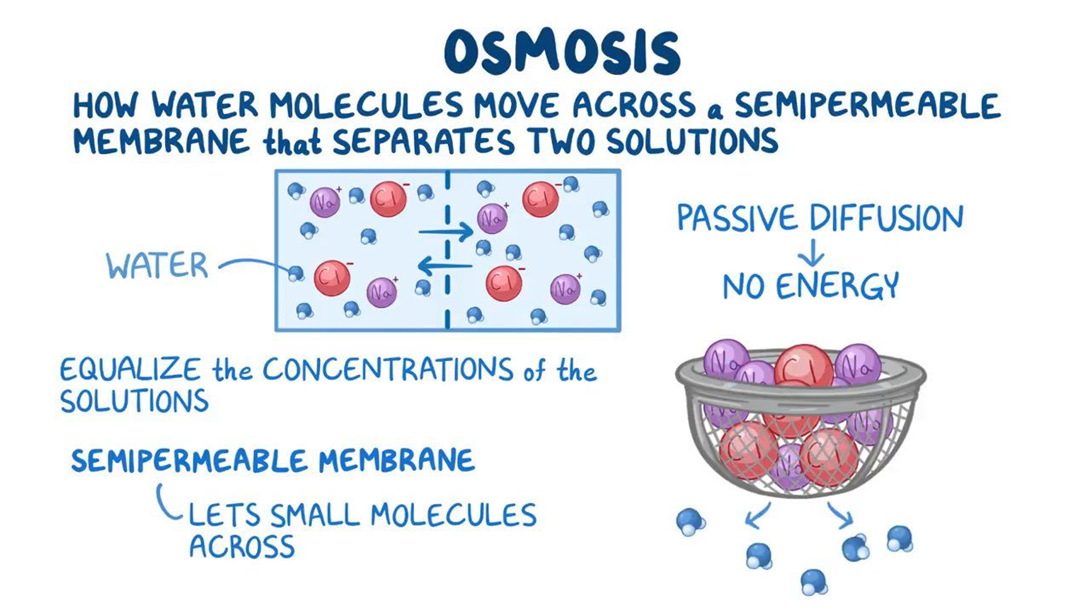Fluid and electrolyte balance is maintained through the process of fluid and solutes moving in and out of cells. What specific process allows fluid to pass through a membrane from a dilute to a more concentrated area?
Active transport
Osmosis
Filtration
Diffusion
The Correct Answer is B
Choice A reason: Active transport is not the process that allows fluid to pass through a membrane from a dilute to a more concentrated area. Active transport is the process that moves solutes across a membrane against their concentration gradient, using energy from ATP. Active transport can create or maintain a concentration difference between two sides of a membrane.
Choice B reason: Osmosis is the process that allows fluid to pass through a membrane from a dilute to a more concentrated area. Osmosis is the movement of water across a selectively permeable membrane from an area of low solute concentration to an area of high solute concentration. Osmosis can equalize the concentration of solutes on both sides of a membrane.
Choice C reason: Filtration is not the process that allows fluid to pass through a membrane from a dilute to a more concentrated area. Filtration is the movement of fluid and solutes across a membrane due to a pressure difference between two sides of a membrane. Filtration can separate solutes from fluid based on their size and charge.
Choice D reason: Diffusion is not the process that allows fluid to pass through a membrane from a dilute to a more concentrated area. Diffusion is the movement of solutes across a membrane from an area of high solute concentration to an area of low solute concentration. Diffusion can also equalize the concentration of solutes on both sides of a membrane.

Nursing Test Bank
Naxlex Comprehensive Predictor Exams
Related Questions
Correct Answer is B
Explanation
Choice A reason: MRI is not a diagnostic procedure for Barrett esophagus. MRI is a type of imaging test that uses magnetic fields and radio waves to create detailed pictures of the internal organs and tissues. It is mainly used to diagnose problems in the brain, spine, joints, and blood vessels.
Choice B reason: EGD is a diagnostic procedure for Barrett esophagus. EGD is a type of endoscopy that uses a flexible tube with a light and a camera to examine the esophagus, stomach, and duodenum. It can detect changes in the lining of the esophagus that may indicate Barrett esophagus, a condition where the normal squamous cells are replaced by columnar cells due to chronic acid exposure.
Choice C reason: Colonoscopy is not a diagnostic procedure for Barrett esophagus. Colonoscopy is a type of endoscopy that uses a flexible tube with a light and a camera to examine the colon and rectum. It is mainly used to screen for colorectal cancer and polyps, as well as to diagnose inflammatory bowel disease and other conditions affecting the lower gastrointestinal tract.
Choice D reason: CT scan is not a diagnostic procedure for Barrett esophagus. CT scan is a type of imaging test that uses X-rays and a computer to create cross-sectional pictures of the body. It is mainly used to diagnose problems in the chest, abdomen, pelvis, and bones.
Correct Answer is C
Explanation
Choice A reason: Reintroducing foods that intensify symptoms one at a time is not an intervention that the nurse would recommend for a client with GERD. Foods that can trigger or worsen GERD symptoms include spicy, acidic, fatty, or fried foods, chocolate, coffee, alcohol, mint, garlic, and onion. The nurse would advise the client to avoid or limit these foods, not to reintroduce them.
Choice B reason: Promoting intake of food and fluids 1 to 2 hours before bedtime is not an intervention that the nurse would recommend for a client with GERD. Eating or drinking close to bedtime can increase the risk of acid reflux, as the stomach contents can flow back into the esophagus when the client lies down. The nurse would suggest the client to have smaller and more frequent meals, and to avoid eating or drinking at least 3 hours before bedtime.
Choice C reason: Maintaining an upright position following meals is an intervention that the nurse would recommend for a client with GERD. Keeping an upright posture can help prevent or reduce acid reflux, as gravity can help keep the stomach contents in place. The nurse would encourage the client to avoid bending, stooping, or lying down for at least 2 hours after eating.
Choice D reason: Increasing the amount of carbonated beverages is not an intervention that the nurse would recommend for a client with GERD. Carbonated beverages can increase the production of gas and stomach acid, which can cause bloating, belching, and acid reflux. The nurse would advise the client to drink water or other non-carbonated fluids, and to avoid drinking through a straw or chewing gum, which can also introduce air into the stomach.
Whether you are a student looking to ace your exams or a practicing nurse seeking to enhance your expertise , our nursing education contents will empower you with the confidence and competence to make a difference in the lives of patients and become a respected leader in the healthcare field.
Visit Naxlex, invest in your future and unlock endless possibilities with our unparalleled nursing education contents today
Report Wrong Answer on the Current Question
Do you disagree with the answer? If yes, what is your expected answer? Explain.
Kindly be descriptive with the issue you are facing.
